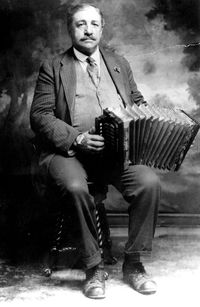Annotation:Valse-Clog des Coteaux: Difference between revisions
No edit summary |
No edit summary |
||
| Line 5: | Line 5: | ||
<br> | <br> | ||
<br> | <br> | ||
[[File:montmarquette.jpg|200px|thumb|left|Alfred Montmarquette]] | |||
"Valse-Clog des Coteaux" was composed by accordion player Alfred Montmarquette [] (1871-1944). | "Valse-Clog des Coteaux" was composed by accordion player Alfred Montmarquette [] (1871-1944). | ||
<br> | <br> | ||
Revision as of 01:46, 8 April 2013
Back to Valse-Clog des Coteaux
VALSE-CLOG DES COTEAUX. French-Canadian, Waltz-clog (3/4 time). D Major. Standard tuning (fiddle). AA'BB'A"A"'B"B"'. The waltz clog, a tap dance in ¾ time, is thought to be derived from German and British immigrants after the American Civil War; as a fad it was popular in the early 1900’s, and perfected by Bill “Bojangles” Robinson and others. In French Canada the waltz-clog is the only British inheritance in the traditional step dancing of the region. It was mostly danced in Montreal and owes its influence mainly to Montreal fiddler Jean Carignan.

"Valse-Clog des Coteaux" was composed by accordion player Alfred Montmarquette [] (1871-1944).
Source for notated version: French-Canadian accordion great Alfred Montmarquette via French-Canadian accordion player Philippe Bruneau (Québec) [Bégin].
Printed sources: Bégin (Philippe Bruneau), 1993; No. 14, p. 23.
Recorded sources:
Back to Valse-Clog des Coteaux
